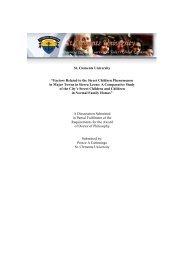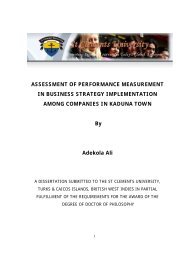Rufus Folorunso Akinyooye - St Clements University
Rufus Folorunso Akinyooye - St Clements University
Rufus Folorunso Akinyooye - St Clements University
Create successful ePaper yourself
Turn your PDF publications into a flip-book with our unique Google optimized e-Paper software.
The committee states that this ratio is expressed as a common minimum standard, which<br />
international Banks in member countries must have observed by the end of 1992. As could be<br />
seen here emphasis is on international banks in G10 member countries or at best OECD. The<br />
rest of this document from Items 45 to 50 was devoted to transitional and implementing<br />
arrangements.<br />
David Clementi (2000) said, “We should of course be under no illusion that the ratios chosen in<br />
1988 were arrived (at) through a scientific process”. To buttress his point he cited an episode<br />
where a Committee member once asked his staff on why the number 3 was chosen for the<br />
calculation of a ratio. He said they answered that two was too low and four too high.<br />
He also did not mince words in saying that the Basel 1 Accord was “aimed principally at<br />
internationally active G10 banks” and that it was designed to spread the risk and penalty of<br />
failure between shareholders and regulatory authorities that could be forced to become lenders<br />
of last resort or liquidators. He said that apart from equity capital acting as buffer against<br />
insolvency, it helps to align the objectives on the firm’s owners with the objectives of the<br />
regulatory authorities. Where the owners of a bank invest pinpoint capital and watch their<br />
bank gradually becoming insolvent through the erosion of capital, they usually come to have<br />
an incentive to “gamble for resurrection” by taking higher risks. He concluded that once their<br />
investment becomes high too, they would have much to lose in the event of a failure. As a<br />
matter of fact they would lose everything especially where the deposits were insured. Milne<br />
and Whalley (1998) argued along the same vein but against regulatory minimum capital<br />
requirement, which they said, once it has fallen below the required minimum could increase<br />
the owners’ appetite for high risks for the sake of survival. Should the high risks fail then the<br />
moral hazard of transferring as much as possible of the banks resources into the hands of the<br />
shareholders (looting) would come in. Either way the shareholders lose because as what<br />
Arturo Estrella et al (1999) called Charter value (an intangible value that disappears with the<br />
closure of the institution) would have disappeared. According to them, the charter value of the<br />
bank produces a strong incentive to the owners of the bank to manage as a going concern. As<br />
long as it remains a going concern owners could always benefit by either selling their<br />
shareholding or watching it appreciate. It would thus be in their interest to keep the bank<br />
afloat and that would also be in the interest of the regulatory authorities that would no longer<br />
have to worry much on a bank failure that could upset the financial applecart. The Basel 1<br />
Accord was in effect a subtle method of getting banks in G10 countries especially the<br />
internationally active ones to be more risk-averse so as not to threaten the economy of their<br />
home countries and by extension those of the entire Group.<br />
Compliance in Nigeria<br />
Most banks in the world including Nigeria embraced this particular provision of capital for<br />
risk-weighted assets and it seems to have become the standard except that CBN stopped short<br />
of requiring banks to actually charge it to their operating profit.<br />
Its circular BSD/11/2003 of August 4, 2003 (effective January 2004) re-calibrated the capital<br />
adequacy measurement of the Basel 1 Accord in an apparent effort to make it fit into the<br />
Nigerian setting as follows:-<br />
RISK WEIGHTS ON-BALANCE SHEET ASSETS<br />
0% Placement with Discount houses secured with Treasury Bills.
















